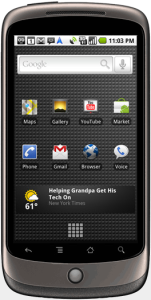I’m sure many of you have seen the prime time TV commercial for the upcoming Verizon Droid mobile device. The majority of you though have probably had no idea what the heck they were even advertising, much less what it does. As reported by CNet, the new Droid is nothing; but a relaunch of the existing Motorola Sholes mobile phone. The unit is a major upgrade to the cell phone that takes the existing T*Mobile Android phones called G1 and MyTouch; moving it to a more robust processor and memory level. So there’s the long and short of it– Droid is a cell phone/mobile device in the vein of the Black Berry Storm or Apple iPhone. I’m sure at this point you have two questions you’d like answered:
- So what’ the big deal with the Droid compared to the iPhone?
- What is an Android and how does it fit in with Droid?
Let’s first explain what Android is. Android is an operating system (software that runs a computer or OS for short) similar to Windows XP or Mac OS X. It lets the hardware (the Moto Sholes in this case) do things like make calls and connect with other devices. It also runs applications (or in cell phone lingo– apps) on the phone to make it more than just a mobile phone. The apps enable the phone to do things similar to computers or laptops like calculators, games, and office programs amongst other things. Android is free and built by Google. Its distribution model is similar to Linux in that it can be openly both added to and used without license fees.
This is different than the iPhone model, which uses open source (freely developed and freely available for use) components from its Mac OS X desktop OS; but relies on proprietary closed source applications to present those applications and run the hardware. The summary version is you can freely use and build off of Android, while with the iPhone Mobile OS X you need to pay license fees to do the same thing.
While iPhone does let anybody freely build apps and distribute them on their network they must be reviewed, as well as, approved by Apple to be offered to the general public. This allows things like the recent blocking of Google Voice’s VoIP service application from being available to the public at Apple or AT&T’s whim. AT&T and Apple claim this was to protect their network (Apple solely offers the iPhone on AT&T cellular service) from the saturation of phone calls that could freely occur on the network. Specifically they cited that the application would allow for a wholesale workaround of termination charges being paid to AT&T by local telephone companies for costly rural land line telephone calling areas. AT&T and Apple state this is the main reason for blocking the app. What it shakes down to is that having app approval allows Apple and AT&T to control what a user can or cannot install on their phone not to mention what they can or cannot do with the phone itself (including how they can or cannot call someone in this case).
The Android OS is different. Because it’s open source; anybody can build anything for it and release it through their own distribution channels including hacking up the underlying OS itself. The idea is Google plans to garner revenue from introducing hardware tuned for the core OS and to offer advertising within the browser through its Google Ads services that target users.
To get an idea on where Google is headed with this concept you merely have to glance over this Business Week interview with Google CEO Eric Schmidt. To quote Schmidt on where mobile data usage is headed and how Google plans to reap revenue from Android (including the Droid handset itself):
What are the biggest challenges the mobile Web presents?
Let’s start with the fact that the phones are not fast, the networks are not as capable, the ad formats are not standardized. But on the other hand it’s very, very important to solve those problems because a phone is very personal. And so if we know a fair amount about a person, with their permission we can target a useful ad—you know, “It’s Eric. You had a hamburger yesterday, do you want pizza today? There’s a pizza store on the right.” That kind of ad is likely worth a lot of money to an advertiser because it will generate a sale.
In other words, you send a message to the person’s cell phone, saying: “Look, we know you had a burger yesterday. If you want pizza today, just go around the block”?
Right. It may sound creepy, but it might also be quite valuable. People could use advice as to what to eat and where the food is—and of course you can turn it off. So the important thing here is advertising that has value to the person is advertising that is a valuable business. That’s the business we’re in.
With that you can see that Android is not built for revenue generation within the OS itself, but the underlying applications and services Google plans to build into the OS as “must have” features to extend that OS into every day life. The hamburger scenario is just a smaller manifesto for a bigger plan that quickly builds with a little extrapolation on the overall vision and direction of Google expressed by Schmidt above.
Apple is reaping profits hand over fist on hardware and software from iPhone not the month to month service. By limiting the supply of iPhone to AT&T though the carrier can make up the service costs by shear volume. The idea is that the iPhone is so hot it will drive both customers and minutes of usage (on voice, video, or data including text SMS) through the roof. In short, with lack of true alternative you have to use the iPhone and because you have to use AT&T to get the iPhone you’re going to terminate information on their network. That means revenue for both parties.
Google and Verizon are using a different model. They plan to make the revenue off what Verizon does best, loading applications and services on top of the base service. Verizon does this by offering sheer service availability with top level saturation of signal. AT&T’s 3G (fastest speed network) is available in most metropolitan areas, but once you get into the suburban footprint that service quickly degrades hobbling the usefulness of mobile connectivity.
Verizon in comparison has near ubiquitous availability of 3G through the continental 48 states in the USA. The result is that the primary functions that people do on their mobile device work fast (web browsing, email, text SMS, and voice) and seamlessly site to site. This is where Droid comes in.
With a 600MHz CPU and 256MB of RAM, the Droid will reach the computing power of your average desktop in 1998 running Windows98. Granted you weren’t going to play DirectX 10 full screen video games, but you were able to play the likes of Doom and Hexen. More importantly you could multitask between two or three applications (check email, surf the web, and chat for example) with ease. This circa 1998 web experience is the exact target Verizon, Google, and Motorola are after. In short, with 80% 3G coverage and infrastructure scaled for broadband anywhere– they hope to make a huge dent in the mobile device market and finally bridge the gap towards Netbooks.
And this is where that second question comes in, Droid is trying to head off iPhone at the ultimate goal; which is to supplant Netbooks with true mobile in your pocket broadband connectivity to voice, video, and data. More appealing to Verizon is that it can leverage the same OS to deploy in home premise equipment as well (Verizon IP set tops and home phones particularly) so users can seamlessly move from phone to home TV using the same interface. That in turn will allow them to reach where their land line FiOS service traditionally cannot. All this with a platform OS not owned by Microsoft or Apple delivered to 80% of the population. The majority of that population that has some other TV or telephone land line service provider outside the traditional Verizon telephone footprint. All without the fees and regulatory requirements of other carriers to do so. It’s not about ubiquity of the hand set at this point. It’s about ubiquity of the service itself. Seamless service delivered from end to end. From home, to road, to work and back. All using one OS platform (Android) to pass that experience along during the trip. A trip not limited by wires, distance, or line of sight.
Now all they need is a media/content partner to provide them their video. Oh wait– Google owns YouTube… never mind. The announcement of YouTube partnering with the big content providers is only a hop, skip, and buffering message away. Then we play the waiting game. The rest is history.



